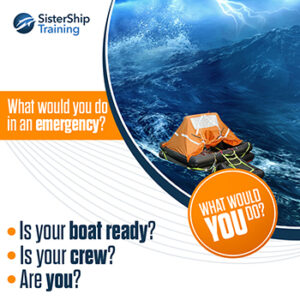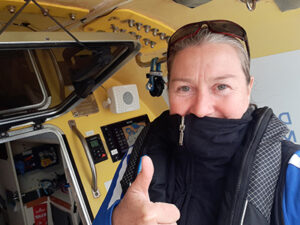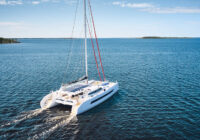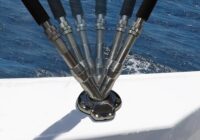No, I don’t mean the places and people, I am talking about the emergencies.
We all hope that we don’t find ourselves in dangerous situations, but hope isn’t enough.

Ask yourself…
Commercial vessel Skippers and crew train hard and often. Their skills are refreshed regularly. They rely on this training, checklists, maintenance up-keep, seaworthiness of their vessel and most of all, they reply on each other.
Are you absolutely certain and confident that if you fell overboard, whomever is left onboard is capable of turning the boat around and rescuing you? In all conditions?
Are you absolutely certain if you had to turn the boat around for your partner, crew, friend, that you could? In all conditions?
Make it Personal
Replace the words Man Overboard to “Noel overboard” – well, don’t use my husband’s name, use your partner’s name. Suddenly it feels a bit more real doesn’t it?
They are depending on you.
Then ask yourself exactly HOW you would do this. And what would you do first? And how would you do that? Can you lift and launch the danbuoy, do you know how your MOB works? Have you ever tested it?
Be honest!
What to do
I hope we all know the basics (it obviously depends on how many there are on board, but here are some very basic reminders):
- Anyone who sees a person go over should shout ‘Man Overboard’, keep their eyes on the person, and point (and continue to point) to them
- Press the MOB button on your GPS/Plotter
- Throw over the danbuoy (or similar)
- Raise the alarm (radio call)
- Stop the vessel, turn around
But What Next?
Where is your MOB equipment?
Have you tested it?
Can you reduce sail?
Do you know how to issue a radio Mayday or Pan Pan?
Do you know how you’d get someone on board, whether they are conscious or not?
Have you considered the different types of MOB, and what you’d do in each case?
*knowing where/when they went over
*not knowing where/when they went over
The best way to survive a MOB situation is to prevent that situation.
MOB Hazards and Prevention
The following are common causes of people falling overboard:
- Sitting on a sail on deck. The wind catches the sail and flips the person sitting on the sail overboard.
- Failure to keep one hand for you and one hand for the boat.
- Standing in a place where it is possible/likely that equipment could push you over (such as in the way of the boom).
- Severe weather. If you have to go on deck, go on the high side of a boat that is heeling, ensure you are clipped on, keep your centre of gravity low (hunker down, small steps), hold on.
- Slippery decks. Decks should be pained with a grip-type paint (fine sand specially prepared, do not gather sand from the beach and use this, it will tear your skin).
- Urinating over the side. As tempting as this is, particularly at night or when no-one is watching, this is a very dangerous activity and a surprisingly common cause of men falling over board.
- List Item
- List Item
Always clip on. Tell someone whenever you are going on deck. Be present and mindful whenever you are on deck. Traverse the high side of the vessel (if heeling), keep your knees bent and keep low. One hand for the boat and one for you. Ensure you have good jacklines that are checked regularly (stitching, knots, placement, chafe, etc).
Where do you start with your preparation?
We’ve done it for you, the bulk of the work that is.
We’ve spent over a year creating two manuals:
- Step-by-step Emergency Preparedness
- An Emergency Safety Response System. A standalone folder with templates (aka Safety Management System – SMS)
We are holding workshops initially around Australian in February, March and April. We will release additional dates soon.
Both manuals are included with the training.
If you prefer to learn alone. Pre-order your manuals here.
There is a special deal for the launch. This is the first round of workshops (and a special deal, prices will increase after the launch).
Taking Readiness to a New Level
We’ve piloted the course to ensure we offer you the very best information, here’s what they say.
‘I must say I’m really enjoying and valuing working my way through the manual. I’m really appreciating the exercises as it really makes you think OK what would I do. Checking it against the scenario guide is either reassuring or helpful in terms of “oh yeah forgot about that or hadn’t thought of that.”’
‘This whole process will certainly not only be helpful in preparing SMSs but motivating to do so as well – mainly because it is not as daunting as it first seems. One SMS at a time – just like one step at a time. Well done.” M.G (on google business reviews).’
“This is FANTASTIC!” (said by 5 participants while clutching the pre-prepared SMS)

After nine years of sailing around the world with her husband Noel, Jackie qualified as a commercial skipper.
She is a Master 5, holds Master 4 qualification, Marine Engine Driver 3, ex-Marine Rescue Skipper (one of the first women in NSW), and current Instructor of professional and recreational level courses.
She’s a Cert 4 Trainer, commercial skipper, recreational sailor (ocean sailing and inland waterways on sailboats and motorboats), Author of practical maritime books/manuals/best-selling memoirs/articles, and Speaker at nautical and book events.
She founded SisterShip Training in 2019. She’s continued to write, freelance, for many different publications for over twenty years, she hosts a podcast show, and has spent over two years in on the European Canals on a Dutch barge. Jackie (with Noel) has traversed The Great Loop in America. She has also (with Lisa Blair) set a sailing record as co-skipper of the first double-handed all-women team in the Melbourne to Hobart race.
You can see all she gets up to here: https://sistershiptraining.com/
And here: https://jackieparry.com/







